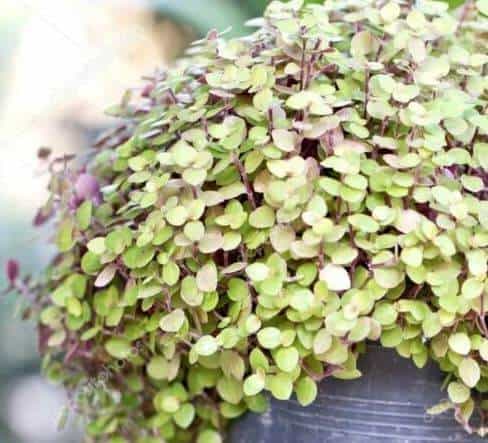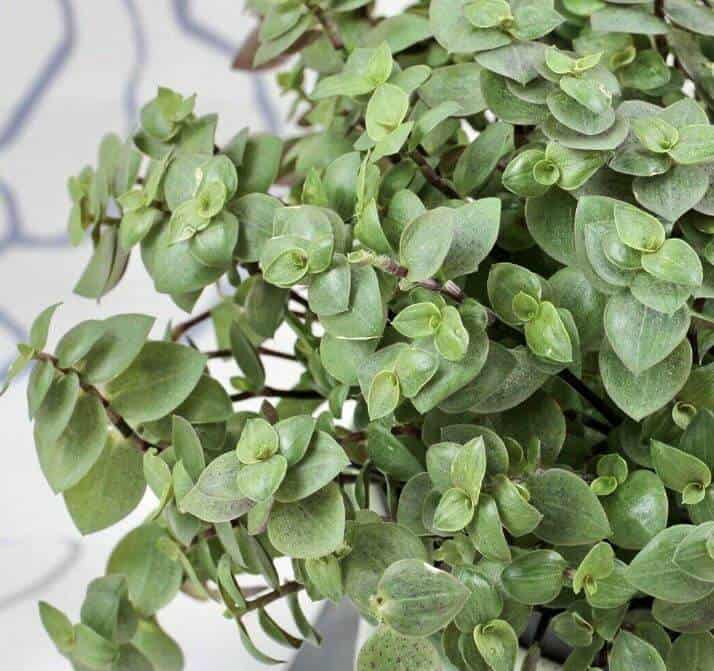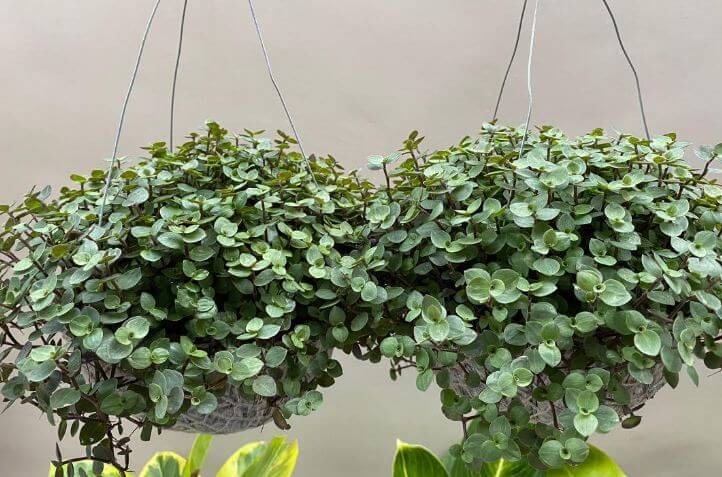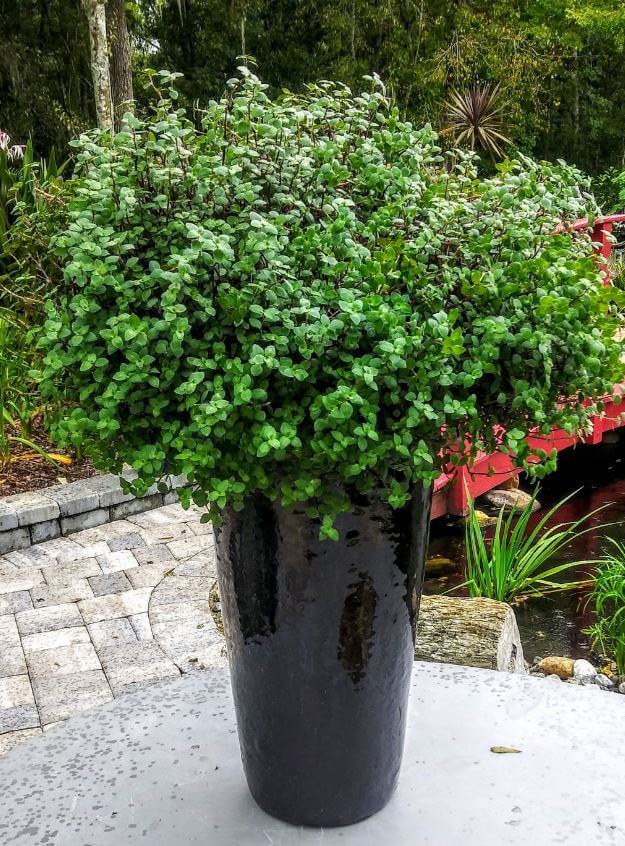Last Updated on January 5, 2023 by a Friendly Gardener
The delightful Afro plant is more commonly known as the Bolivian Wandering Jew. Botanically named the Callisia repens, it is a member of the Spiderwort or Commelinaceae family. Native to Central and South America as well as the Caribbean, it is a popular houseplant in cooler climates or a perennial groundcover in the southern regions of the United States.
This trailing plant has quite a few nicknames other than the Afro plant, so you may have seen one with a different moniker. These include
- Tiny Buttons plant
- Chain plant
- Turtle Vine
- Creeping Basket or Creeping Inch plant
- Little Jewel
- Itsy Bitsy Inch plant
- Dwarf Wandering Jew plant
Easy to grow and vigorous, the Afro plant can be cultivated outdoors in U.S. hardiness zones 10 to 12. Outside of this type of climate, it is cultivated as an annual or indoors. Low-growing and evergreen, the Afro plant sprawls quite rapidly.
The Afro Plant / Bolivian Jew Plant vs. the Wandering Jew Plant

Wandering Jewas is a name that is applied to various plants, however, the most well-known is probably the Wandering Jew plant or Tradescantia zebrina with its silver and purple pointy foliage. The Tradescantia genus includes numerous plants that have similar needs and habits.
The Callisia repens also belongs to the Tradescantia genus but is a different plant species. It features foliage with pink and cream markings. Leaves are small and grow close together on stems giving the Bolivian Wandering Jew a ball shape. When cultivated indoors, they make fantastic hanging plants in baskets or when placed on high shelves.
Afro Plant Care

This species shares characteristics with most other Jew plants. They root and spread easily, growing very quickly. As a vining or trailing plant, it can reach heights measuring between 4 inches and a foot while creeping stems can reach 2 feet in length.
The Afro plant will produce stalkless clusters of small 3-petaled white blossoms during the summer into the fall. Hermaphrodite blooms are odorless and usually sprout in pairs. Seed capsules with brown seeds develop once fertilization takes place.
Soil
Quality potting soil or a peat mix will work fine for the Afro plant. In the outdoor garden soil should be organically rich or amended with organic material. Plant containers should feature drainage holes.
Light
Your Afro plant will appreciate the exposure to some full sun but prefer partial shade. Adequate bright light helps prevent the plant from becoming leggy or straggly in appearance. When cultivating indoors, find a sunny spot near a window but beware that too much direct sun exposure may burn foliage. If your plant doesn’t receive adequate sun, color intensity may fade.
Water
The Afro plant requires an evenly moist soil bed during its growing season. During the winter, the soil surface can be allowed to dry out. Plan on watering every 5 to 7 days depending on your climate or when the top 2 inches of the soil surface feels dry to the touch. If your plant appears to wilt, it’s time to water, however, be careful to avoid overwatering. Water the Afro plant at the plant base to prevent wetting leaves.
Humidity
Average to high home humidity levels make for a happy plant. If humidity levels drop too low, leaves will turn brown and die. This is a major challenge during winter heating. Space humidifiers help as does locate your plant in a steamy bathroom. Humidity monitors are helpful when cultivating these types of plants. You can also use a pebble tray and mist often.
Temperature
These plants do not tolerate the cold for long and will die if exposed to frost if you are cultivating outdoors. They can survive brief exposure to extreme temps both hot and cold. Higher temps are tolerable when the plant is partially shaded and in a spot with high humidity.
Temperatures should range between 50° and 80°F.
Feeding
Not a heavy feeder, the Afro plant can do with a bit of liquid fertilizer formulated for foliage plants every 2 weeks during the summer season to encourage foliage growth. If you have doubts about fertilizer strength, dilute the fertilizer before application as roots can be damaged if the fertilizer is too strong.
Pruning

The Afro plant requires little pruning, but if you want a compact plant appearance, pinch stem tips. This will help maintain the shape and encourage growth. After two years of age, these plants do have a tendency to become leggy, so you may want to propagate a new plant using stem cutting.
Potting or Repotting the Afro Hanging Plant

If your Afro plant has proper environmental conditions, it’s likely the plant will fill its pot with root growth relatively quickly. Plan on repotting annually unless you see roots peeking from the soil surface or drainage holes sooner. Ne pots should be approximately 2 inches larger.
Afro Plant Propagation

You can propagate an Afro plant using seeds however, the easiest method is to propagate using a stem cutting. Plan on propagating during the spring or at the beginning of summer.
Take a 2 to 4-inch stem cutting with leaf nodes and place it in your garden. Cover it with a light dusting of soil. New foliage should appear within days.
For container propagation, dip the cut end of the stem section in rooting hormone and place it in moist soil. Keep the soil bed moist so that the cutting develops roots.
Cuttings can also be placed in a jar of water until new roots develop. Change the water every few days. Once roots develop, your cutting can be transplanted into soil.
Afro Plant Problems
The Afro plant is relatively resistant to a majority of the pests that regularly afflict houseplants. If humidity is low, red spider mites may appear. You‘ll notice webbing throughout the tips of stems. Regular misting of the plant can help maintain adequate humidity levels to keep these pests at bay.
Also, watch for aphids and fungus gnats. All these pests can be controlled by using insecticidal soap or applying organic Neem oil.
Leggy growth usually indicates insufficient light, so consider moving your plant. Dull or faded foliage can indicate a lack of light or too much light.
Brown leaves signal too little water or too little humidity, whereas yellow leaves are almost always a sign of overwatering.
Afro Plant Toxicity
The Afro plant is known to contain calcium oxalate crystals, so if your cat or dog bites or chews on vines or foliage expect a reaction. Pets may also develop a red rash that itches when coming into direct contact with the plant. It’s best to avoid problems altogether by placing your plant in an unreachable hanging basket or high enough so the cat can’t climb up and nibble.

